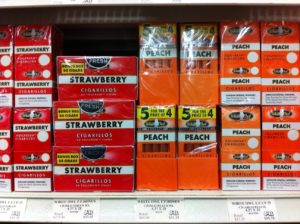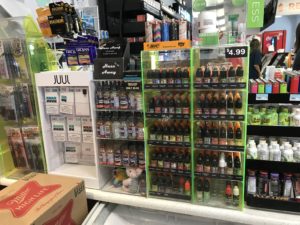Welcome to CounterTobacco.org’s “News and Research Roundup!” Each month we post a summary of the latest research, reports, and news stories on counteracting tobacco product sales and marketing at the point of sale (POS). Keeping up with what’s happening in the POS movement all across the country can help you choose policies and strategies that work best for your community. New research can help provide support for your work and evidence for the importance of the “War in the Store.” Have a story you don’t want us to miss? E-mail it to us!
New Research
Flavored Tobacco Products
- Flavored tobacco sales prohibition (2009) and noncigarette tobacco products in retail stores (2017), New York City, American Journal of Public Health
- This study assessed the availability of “explicit” flavored tobacco products (those with clearly labeled flavors ) and “concept” flavored tobacco products (those implying flavor,
 but not clearly labeled) in over 1,500 retailers in New York City in 2017. Despite legislation passed in 2009 restricting the sales of flavored tobacco products, the majority of retailers in 2017 sold either explicit flavored tobacco products (71%) or concept flavored tobacco products (69%). Both explicit and concept flavored products were more widely available at retailers in neighborhoods with a higher proportion of non-Hispanic black residents and at retailers located near a high school. With flavors still rampant despite the ban, this study highlights the need for retailer education and increased enforcement efforts. Learn more about restricting product and flavor availability.
but not clearly labeled) in over 1,500 retailers in New York City in 2017. Despite legislation passed in 2009 restricting the sales of flavored tobacco products, the majority of retailers in 2017 sold either explicit flavored tobacco products (71%) or concept flavored tobacco products (69%). Both explicit and concept flavored products were more widely available at retailers in neighborhoods with a higher proportion of non-Hispanic black residents and at retailers located near a high school. With flavors still rampant despite the ban, this study highlights the need for retailer education and increased enforcement efforts. Learn more about restricting product and flavor availability.
- This study assessed the availability of “explicit” flavored tobacco products (those with clearly labeled flavors ) and “concept” flavored tobacco products (those implying flavor,
- Compliance with San Francisco’s flavoured tobacco sales prohibition, Tobacco Control
- This study looked at tobacco retailer compliance rates in San Francisco, California after a 2018 vote to ban all flavored tobacco products, including menthol, followed by a four month educational campaign for retailers about the new ban. From January to December 2019, all stores were inspected and the average compliance rate was 80%. These findings suggest that educating retailers prior to enforcement can lead to strong compliance rates. Learn more about flavored tobacco restrictions.
- Do JUUL and e-cigarette flavours change risk perceptions of adolescents? Evidence from a national survey, Tobacco Control
- Using a national survey of over 1,600 high school students in 2018, researchers assessed the association between flavor profiles and risk perceptions. Risk perceptions varied significantly by flavor type for both JUUL products and e-cigarettes. Relative to
 the tobacco flavor, teen respondents perceived fruit flavors to be less likely to lead to lung cancer, less likely to have harmful second-hand vapor, and more likely to be healthy; despite perceiving them as less harmful than tobacco flavors, teens did, however, perceive the fruit flavors to be more addictive than the tobacco flavors. Similar evidence was found for candy, menthol/mint, and alcohol flavors of vape products, though the magnitude was not as large as for fruit flavors. The findings suggest that bans on fruit and other flavors could reduce the appeal of vape products to youth. Learn more about flavored tobacco products.
the tobacco flavor, teen respondents perceived fruit flavors to be less likely to lead to lung cancer, less likely to have harmful second-hand vapor, and more likely to be healthy; despite perceiving them as less harmful than tobacco flavors, teens did, however, perceive the fruit flavors to be more addictive than the tobacco flavors. Similar evidence was found for candy, menthol/mint, and alcohol flavors of vape products, though the magnitude was not as large as for fruit flavors. The findings suggest that bans on fruit and other flavors could reduce the appeal of vape products to youth. Learn more about flavored tobacco products.
- Using a national survey of over 1,600 high school students in 2018, researchers assessed the association between flavor profiles and risk perceptions. Risk perceptions varied significantly by flavor type for both JUUL products and e-cigarettes. Relative to
- Flavored e-cigarette sales in the United States under self-regulation from January 2015 through October 2019, American Journal of Public Health
- Researchers tracked sales of e-cigarettes from January 2015 to October 2019. They found that, as JUUL’s growth boomed, the overall sales of fruit-flavored e-cigarettes rose in accordance. In fact, the percentage of sales from fruit-flavored products increased 20% from January 2017 to October 2018, and actually briefly surmounted the percentage of sales from menthol/mint flavored products in October 2018. When JUUL voluntarily removed their fruit-flavored pods from shelves in November 2018, the whole fruit-flavored market was affected and market sales of fruit-flavored products declined to 9.1%. During this time, however, the share of mint/menthol-flavored products rose from 33% to 62.5% and the share of tobacco-flavored products rose from 16.6% to 22.3%. JUUL alone captured all the growth from the mint/menthol market and, within 12 weeks of removing their fruit-flavored pods from the market, surpassed their previous maximum sales. Learn more about menthol tobacco products.
- News story: Juul’s sales grew even after dropping flavored e-cigarettes, U.S. News & World Report
- Ban on menthol-flavoured tobacco products predicts cigarette cessation at 1 year: A population cohort study, Tobacco Control
- At the beginning of 2017, Ontario, Canada banned menthol-flavored tobacco products.
 This study surveyed smoking and cessation behaviors in current smokers before and after the menthol ban. At follow-up in 2018, over half of ‘daily’ and ‘occasional’ menthol smokers reported making a quit attempt since the ban. Additionally, 24% of daily menthol smokers and 20% of occasional menthol smokers reported quitting smoking after the ban; in comparison, 14% of non-menthol smokers quit smoking at follow-up.
This study surveyed smoking and cessation behaviors in current smokers before and after the menthol ban. At follow-up in 2018, over half of ‘daily’ and ‘occasional’ menthol smokers reported making a quit attempt since the ban. Additionally, 24% of daily menthol smokers and 20% of occasional menthol smokers reported quitting smoking after the ban; in comparison, 14% of non-menthol smokers quit smoking at follow-up.
- At the beginning of 2017, Ontario, Canada banned menthol-flavored tobacco products.
E-Cigarettes
- Do state regulations on e-cigarettes have impacts on the e-cigarette prevalence?, Tobacco Control
- Researchers assessed five types of state-level e-cigarette regulations– defining e-
 cigarettes as tobacco products, enacting a non-sales tax on e-cigarettes, restricting packaging, prohibiting youth access/setting a higher minimum legal sales age for e-cigarettes, and requiring e-cigarette licenses for retail – and their impact on e-cigarette initiation and use. Across the whole sample, all state-level laws were associated with lower odds of e-cigarette initiation and use. Stratified by age, these associations, however, were not consistently observed. For instance, requiring licensing for e-cigarettes and raising the minimum legal sales age were the only policies that reduced e-cigarette initiation among young adults. When licensing was established, 18-24-year-olds were 6% less likely to initiate e-cigarette use and when the minimum legal sale age was raised to 19, young adults were 18% less likely to initiate e-cigarette use. As well, researchers found that states with four or five e-cigarette regulations tended to have lower rates of e-cigarette initiation and use, compared to states with two regulations or fewer. This study suggests that the impact e-cigarette regulations may have on initiation and use vary across states and age groups. Learn more about different policy solutions for tobacco control.
cigarettes as tobacco products, enacting a non-sales tax on e-cigarettes, restricting packaging, prohibiting youth access/setting a higher minimum legal sales age for e-cigarettes, and requiring e-cigarette licenses for retail – and their impact on e-cigarette initiation and use. Across the whole sample, all state-level laws were associated with lower odds of e-cigarette initiation and use. Stratified by age, these associations, however, were not consistently observed. For instance, requiring licensing for e-cigarettes and raising the minimum legal sales age were the only policies that reduced e-cigarette initiation among young adults. When licensing was established, 18-24-year-olds were 6% less likely to initiate e-cigarette use and when the minimum legal sale age was raised to 19, young adults were 18% less likely to initiate e-cigarette use. As well, researchers found that states with four or five e-cigarette regulations tended to have lower rates of e-cigarette initiation and use, compared to states with two regulations or fewer. This study suggests that the impact e-cigarette regulations may have on initiation and use vary across states and age groups. Learn more about different policy solutions for tobacco control.
- Researchers assessed five types of state-level e-cigarette regulations– defining e-
- Exploring the point-of-sale among vape shops across the US: Audits integrating a mystery shopper approach, Nicotine & Tobacco Research
- In the summer of 2018, mystery shoppers examined regulatory compliance in 30 randomly selected vape shops in six US cities. Though 95% of shops displayed
 minimum-age signage, only about a third of shops asked for age verification upon entry and less than a quarter of shops asked for age verification upon purchase. 86% of stores had some degree of compliance with FDA health warnings. Despite the general compliance with minimum age signage and health warnings, 16% of vape shops offered free samples of e-liquids, 29% had signage with prohibited health claims, 33% were within two blocks of a school, 83% offered price promotions and 90% had signage for product and price promotions. Learn more about e-cigarettes at the point of sale.
minimum-age signage, only about a third of shops asked for age verification upon entry and less than a quarter of shops asked for age verification upon purchase. 86% of stores had some degree of compliance with FDA health warnings. Despite the general compliance with minimum age signage and health warnings, 16% of vape shops offered free samples of e-liquids, 29% had signage with prohibited health claims, 33% were within two blocks of a school, 83% offered price promotions and 90% had signage for product and price promotions. Learn more about e-cigarettes at the point of sale.
- In the summer of 2018, mystery shoppers examined regulatory compliance in 30 randomly selected vape shops in six US cities. Though 95% of shops displayed
- E-cigarette product characteristics and subsequent frequency of cigarette smoking, Pediatrics
- Analysis of data from over 1,300 participants in the Southern California Children’s Health Study found that baseline past-30-day e-cigarette use was associated with a greater frequency of past-30-day cigarette use at 1 year follow-up. As well, those who reported smoking modifiable e-cigarettes [mods] at baseline smoked more than 6 times as many cigarettes at follow-up, compared to those who reported smoking vape pens at baseline. This study suggests a need to look at specific e-cigarette device types when considering regulatory action. Learn more about e-cigarettes.
- News story: Adolescents smoking mods will smoke 6x more cigarettes later on: Study,
 The Science Times
The Science Times
- Perceived addition to vaping among youth and young adult regular vapers, Tobacco Control
- This Canadian study looked at youth and young adults’ perceived level of addiction to vaping. Nearly half of youth who were regular users, defined as those who vaped at least weekly, reported that they were “somewhat addicted” to e-cigarettes and 13% reported they were “very addicted” to e-cigarettes. As well, those who vaped higher nicotine strengths had a greater likelihood of higher perceived addiction than those who vaped products of low nicotine strength, suggesting policies setting a maximum nicotine strength could have a public health impact on youth and young adults. Learn more about youth appeal tactics used by the tobacco industry.
International
- Cross-country comparison of cigarette and vaping product marketing exposure and use: Findings from 2016 ITC Four Country Smoking and Vaping Survey, Tobacco Control
- Using data from the 2016 ITC Four Country Smoking and Vaping Survey, researchers analyzed differences in exposure and use of cigarette and vaping products across the
 four countries. Reported exposure to POS cigarette advertising was significantly higher in the US (52%), than in Australia, Canada, and England (11-19%). Reported exposure to POS vaping advertising was only slightly higher in England (49%) than in the US (46%). As well, exposure to and use of price promotions for vaping products was, by far, the highest in the US than in any of the other three countries. Learn more about the war in the store.
four countries. Reported exposure to POS cigarette advertising was significantly higher in the US (52%), than in Australia, Canada, and England (11-19%). Reported exposure to POS vaping advertising was only slightly higher in England (49%) than in the US (46%). As well, exposure to and use of price promotions for vaping products was, by far, the highest in the US than in any of the other three countries. Learn more about the war in the store.
- Using data from the 2016 ITC Four Country Smoking and Vaping Survey, researchers analyzed differences in exposure and use of cigarette and vaping products across the
- Relationships between smoking duration, smoking intensity, hypothetical tobacco price increases, and smoking habit change intention among current smokers in Shanghai, The Journal of International Medical Research
- This cross-sectional study explored the impact of a hypothetical increase in tobacco prices on intention to smoke less or quit. 75% of smokers reported intention to smoke less and 60% of smokers reported intention to quit smoking if tobacco prices doubled. Smokers with a longer smoking history and lower smoking intensity were more likely to report that they would change their smoking behaviors as a result of a price increase in tobacco. These findings suggest that raising tobacco prices could encourage cessation attempts. Learn more about increasing tobacco prices through non-tax approaches.
- Impact of a ban on the open display of tobacco products in retail outlets on never smoking youth in the UK: Findings from a repeat cross-sectional survey before, during and after implementation, Tobacco Control
- A ban on the open display of tobacco products in the UK was implemented between
 2012 and 2015. Using a repeat cross-sectional survey with data collected pre-ban in 2011, mid-ban in 2014, and post-ban in 2016, researchers assessed the ban’s impact on never-smokers. Pre-ban, 81% of never-smokers reported exposure to cigarettes at the POS, whereas post-ban, only 28% of never-smokers reported exposure to cigarettes at the POS. Researchers also determined that never-smokers at pre-ban were 31% more likely to be susceptible to smoking than never-smokers at mid-ban. Alternatively, never-smokers at post-ban were 21% less likely to be susceptible to smoking than never-smokers at mid-ban. Learn more about restricting tobacco advertising.
2012 and 2015. Using a repeat cross-sectional survey with data collected pre-ban in 2011, mid-ban in 2014, and post-ban in 2016, researchers assessed the ban’s impact on never-smokers. Pre-ban, 81% of never-smokers reported exposure to cigarettes at the POS, whereas post-ban, only 28% of never-smokers reported exposure to cigarettes at the POS. Researchers also determined that never-smokers at pre-ban were 31% more likely to be susceptible to smoking than never-smokers at mid-ban. Alternatively, never-smokers at post-ban were 21% less likely to be susceptible to smoking than never-smokers at mid-ban. Learn more about restricting tobacco advertising.
- A ban on the open display of tobacco products in the UK was implemented between
- Effects of an 80% cigarette price increase on quit attempts, successful quitting and smoking intensity among Korean adult smokers: Results from nationally representative longitudinal panel data, Tobacco Control
- In 2015, South Korea raised the price of cigarettes by 80%. Drawing on data from a nationally representative longitudinal study from 2014 to 2017, researchers aimed to assess the impact of this price hike on smoking behaviors of baseline adult smokers. After the increase in cigarette price, 61% of baseline smokers attempted to quit, with 35% successfully quitting smoking. Quit attempts and successfully quitting were more common in older and light smokers, compared to younger (ages 35-44) and heavy smokers. This study highlights the impact a price increase on tobacco products may have on smoking cessation. Learn more about increasing tobacco prices.
Disparities
- Are state-level income-based disparities in adult smoking declining?, Preventative Medicine
- Data from the Behavioral Risk Factor Surveillance System was pulled for all states and Washington D.C. from 2011 to 2017. Over this time period, 47 states had no change in income-based disparities in smoking. Three states (Florida, Maine, and West Virginia)
 saw increased disparities as smoking prevalence dropped solely among higher-income groups. New York was the only state where smoking prevalence declined more for lower-income populations compared to higher-income populations. Overall, in 2017, lower-income populations in all states were 1.4-3 times more likely to smoke compared to higher-income populations. Though tobacco control strategies have been implemented over this time frame that have reduced overall smoking prevalence, researchers suggest that pro-equity solutions need to come to the forefront to reduce these income-based disparities. Learn more about health equity and point-of-sale tobacco control policy.
saw increased disparities as smoking prevalence dropped solely among higher-income groups. New York was the only state where smoking prevalence declined more for lower-income populations compared to higher-income populations. Overall, in 2017, lower-income populations in all states were 1.4-3 times more likely to smoke compared to higher-income populations. Though tobacco control strategies have been implemented over this time frame that have reduced overall smoking prevalence, researchers suggest that pro-equity solutions need to come to the forefront to reduce these income-based disparities. Learn more about health equity and point-of-sale tobacco control policy. - News story: New Yok only state to reduce income-based disparities in smoking, study finds, UNC Gillings School of Global Public Health
- Data from the Behavioral Risk Factor Surveillance System was pulled for all states and Washington D.C. from 2011 to 2017. Over this time period, 47 states had no change in income-based disparities in smoking. Three states (Florida, Maine, and West Virginia)
- Disparities in current cigarette smoking among US adults, 2002-2016, Tobacco Control
- Using data from the 2002-2016 National Survey on Drug Use and Health, researchers determined that, over this time frame, current cigarette smoking prevalence declined overall and in all subgroups, except American Indians/Alaska Natives and Medicare insures. However, inequities in cigarette smoking actually remained unchanged or, in many instances, even increased when analysis was broken down by variables, such as annual family income, education, and race/ethnicity. When researchers compared groups with the least social advantages to those with the most, they found the single greatest disparity in current cigarette smoking was along racial/ethnic lines. In fact, if racial/ethnic disparities in smoking were extinguished and smoking prevalence among all racial groups were to be reduced to the same level, the number of past 30 days smokers would essentially be halved. Learn more about disparities in point of sale advertising and retailer density.
- Taxation reduces smoking but may not reduce smoking disparities in youth, Tobacco Control
- Analysis of data from the Monitoring the Future study from 2005-2016 found that higher
 cigarette taxes are associated with reduced smoking among adolescents. When stratified by race/ethnicity, socioeconomic status, and gender, there were no significant differences in smoking behaviors, suggesting that, while higher taxes may reduce adolescent youth cigarette use, they likely do not reduce smoking disparities among youth across race/ethnicity, socioeconomic status or gender. Learn more about tobacco industry tactics used to target youth.
cigarette taxes are associated with reduced smoking among adolescents. When stratified by race/ethnicity, socioeconomic status, and gender, there were no significant differences in smoking behaviors, suggesting that, while higher taxes may reduce adolescent youth cigarette use, they likely do not reduce smoking disparities among youth across race/ethnicity, socioeconomic status or gender. Learn more about tobacco industry tactics used to target youth.
- Analysis of data from the Monitoring the Future study from 2005-2016 found that higher
Other
- Hookah venue employees’ knowledge and perceptions of hookah tobacco smoking, Tobacco Control
- In this mixed methods study of a small sample of hookah bar employees, researchers determined that hookah bar employees had limited knowledge of the potential harms of hookah and second hand smoke exposure; for instance, only 17% of participants correctly believed that hookah was not safer than cigarettes and only 8% correctly believed that the hookah water bowl does not filter out toxins. This study suggests the need for educational campaigns to inform hookah bar employees of the risks associated with hookah. Learn more about hookah at the point of sale.
Industry News
- FTC sues to unwind Altria’s $12.8 billion investment in competitor JUUL, Federal Trade Commission
- BAT files patent suits against Philip Morris’ IQOS products, Reuters
- Altria CEO steps down from the Marlboro cigarette maker, The Wall Street Journal
- Private antitrust action follows FTC complaint against Altria and Juul over e-cigarette deal, The National Law Review
- Tobacco, vaping industries seize opportunities in coronavirus with freebies, donations, Los Angeles Times
- Philip Morris money is funding pro-vaping coronavirus spin, San Antonio Express-News
POS Policy in the Media
E-Cigarettes
- FDA requests federal court extend premarket application deadline on e-cigarettes to September, Winston-Salem Journal
- Tobacco manufacturers get FDA deadline extension for e-cigarettes, The Washington Times

- The world pushes back against e-cigarettes and Juul, The New York Times
- [Montgomery County, MD] Vapes, e-cigarette sales can’t be near county middle, high schools, Bethesda Magazine
- Utah Gov. Gary Herbert signs bill meant to curb youth vaping, The Salt Lake Tribune
Menthol and Other Flavored Tobacco Products
- Anti-vaping bills among the 125 signed into law by Utah’s governor, Fox 13 Salt Lake City
- [NY] Governor Cuomo announces highlights of FY 2021 budget, NY.gov
- [CA] Solana Beach bans flavored tobacco products, The Coast News Group
- [MN] Temporary ban on sale of flavored e-cigarettes ends, KULR8
Tobacco Retailer Licensing
- [NY] Bethlehem Town Board considers licensing system for tobacco, vapor retailers in town, Spotlight News
Other
- [Elk Grove, CA] City Council extends moratorium on new smoking lounges, tobacco retailers, Elk Grove Citizen
Find more stories in last month’s News and Research Roundup.
Know of a story that we missed? Email us, and we’ll be sure to include it in next month’s roundup!


